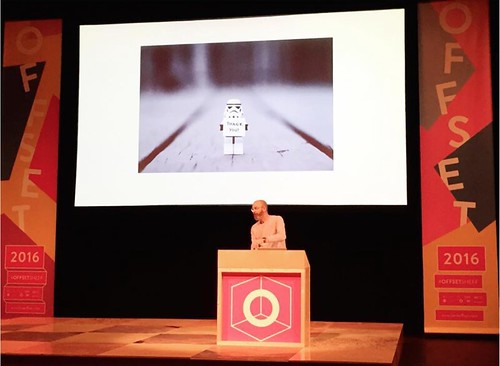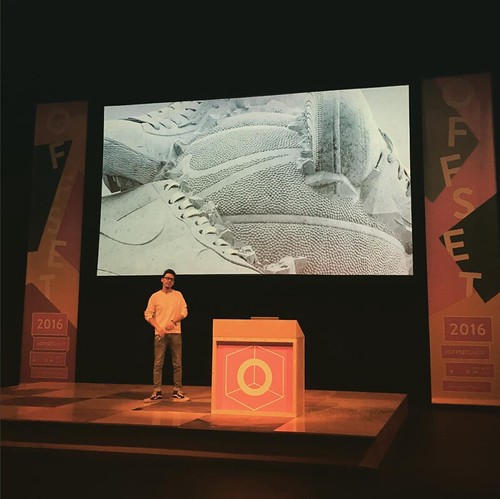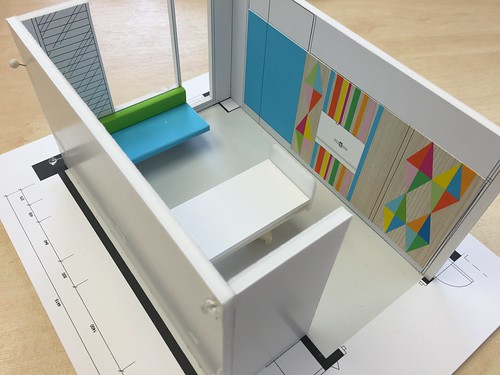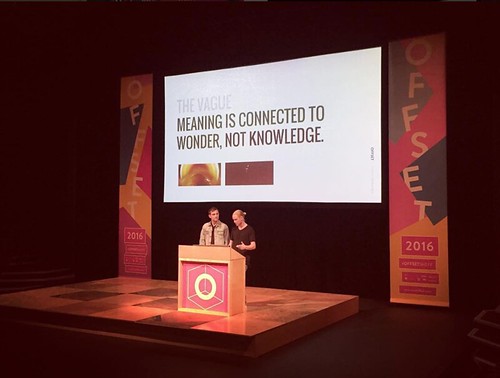Friday, 9:00am
11 November 2016
Offset Sheffield 2016: day two
sheffield
Design education
Design history
Graphic design
Illustration
Photography
Reviews
Technology
Florence Blanchard, LEGO, Shane Griffin, Ben Bos, Laura Carlin, Sabrina Bongiovanni, TDR, Cat Powell, Morag Myerscough & Droga5 in Sheffield

The second of two reports from Offset Sheffield … written by final-year students at Sheffield Institute of Art’s Graphic Design and Illustration course. The first day’s report can be read here.
Day two kicked off with Florence Blanchard, the French painter, muralist and illustrator who now lives and works in Sheffield, co-running B&B Gallery with Ed Bradbury. Blanchard was a graffiti artist (tagging under the name ‘EMA’) who gained a PhD in molecular biology – she ran through her eclectic influences and her own work in a portfolio of bright colours, eccentric shapes and bold patterns – as at home on the walls of the gallery as they are the darkest of alleyways.
Despite finding inspiration in heavily scientific or statistical subject matter, the abstract shapes and squiggles of the microscopic come together in forms that capture the attention and intrigue passers-by regardless of their scientific knowledge. Blanchard, who received no formal creative tuition herself, was keen to relate this back to arts practice. For her, anyone can enjoy and create art, and a lack of art education should never inhibit creative practice.
LEGO Star Wars design director Jens Kronvold Frederiksen.

This theme of ‘unfettered creativity’ continued throughout the morning on the main stage, with Jens Kronvold Frederiksen – design director of LEGO Star Wars – discussing all things brick-shaped. Frederiksen mentioned how this influences the design of new ranges, from the ergonomic design considerations between adults and children, to the accidental creation of the LEGO Millennium Falcon – which would turn out to be the largest LEGO set ever made (briefly) – a personal ‘project’ that Frederiksen had started on just for fun, but that was spotted on his desk by an eagle-eyed colleague.
Shane Griffin.

Shane Griffin, New York based designer and motion graphic artist, also advocated the role of experimentation and play, seeing a move away from commercial briefs as a chance to showcase ideas or test new thinking. With a keen eye (or perhaps an obsession) for detail, Griffin’s desire to keep pushing himself led him to take the leap from 3D rendered imagery into real life sculpture (as part of a commission for Nike) and beyond, creating a ‘Rube Goldberg’ (or Heath-Robinson) style machine for a single-take advert for the National Lottery.
Griffin was followed by Ben Bos of Total Design (see ‘The gridniks’ in Eye 79), who had a fair amount of design work to show. Rounding up the morning with a whistle-stop tour of a design career spanning more than 50 years, Bos’s work – as ever – looked as fresh and meticulously considered as any contemporary counterpart.
Illustrator Laura Carlin and photographer Sabrina Bongiovanni spoke about the ups and downs of breaking into their respective industries – important information for students to hear.
Text by Ian Anderson (See Eye 71).

Friday’s speaker, TDR’s Ian Anderson, was joined on the main stage by a panel of Sheffield-based designers (Patrick Murphy of Made North gallery, Thom Barnett of Mamnick menswear, and Mike and Katie of Tado design studio) to discuss place and creativity.
As a prelude to the discussion, Anderson offered up the age-old question that plagues designers approaching the end of their higher education, about to dive into the world of industry: whether you have to go to London to be a successful designer. This seems to be a particular concern for Northern (and Northern-based) students, and a fitting question to raise at a design conference that has now appeared in both the capital and Yorkshire as a complement to its Dublin origins. The panel argued that in the case of graphic design practice, wherever you learn your craft, the potential springboard for your career comes through the connections you make, the experience of the place, and your passion for the subject.
Despite the general trend of moving to London to pursue a creative career – the panel members went to lengths to stress the potential outside the capital. Much of the remaining discussion centred around ‘passion’ being the catalyst for creativity, suggesting that responsibility lay with designers to create places that epitomised the kind of extended creative industry they aspired to join – regardless of the town or city’s size.
Artfelt collaborative design with Morag Myerscough for bedrooms at Sheffield's Children's Hospital.

Perhaps, however, Anderson missed the fact that in Sheffield this is already happening – and very successfully so – via people like Cat Powell. Powell, the manager of Artfelt (a charity that works to make the experience of staying in hospital more bearable for patients and families at Sheffield Children’s Hospital through environmental design) spoke directly afterwards over on the second stage with collaborator Morag Myerscough (see Eye 79).
Although both had previously created environments within a hospital setting, their latest project together – the redesign of an entire ward, that needed to cater for the tastes of children of all ages, their families and hospital staff, while radically departing from the traditional, grey sterility – was unprecedented in terms of scale. For anyone familiar with Myerscough’s work, it goes without saying that the proposal and final designs were anything but grey and sterile, and unsurprisingly, the pair were met with reservation from staff initially, with such a radical move away from traditional ‘hospitalness’.
Although the work had incredible aesthetic and (hopefully) emotional impact on those experiencing it, the real highlight of the conversation was the genuine friendship struck up between the two, beautifully illustrating how vital it can be to have the support of a non-design collaborator when pushing boundaries, as well as the importance of working relationships and how they can completely transform the experience of tricky projects.
Felix Richter and Alexander Nowak from Droga5.

Offset’s intensive 48 hours of talks, presentations and discussions was rounded up by Felix Richter and Alexander Nowak, Creative Directors at Droga5, who started with an apology – acknowledging advertising’s ‘bad rep’ and the disdain for the practice within other creative fields. The pair spoke about how this public resistance has forced them to consider and reconsider their practice, developing the concept of ‘postmodern advertising’. Despite Nowak’s assertion that humour can be difficult for Germans – the pair spoke about how they employ irony, absurdity, and playfulness to break down preconceptions of advertising – allowing for an enjoyable viewing experience.
Professional and student delegates left the Crucible theatre full of inspiration: Offset’s first Sheffield venture coincided neatly with the beginning of the city’s Design Week. Sheffield’s creative heritage was discussed at length throughout the weekend, and the potential of the city as a viable alternative to the London-centric design industry is in no doubt bolstered by initiatives and festivals such as these – bringing the best the industry has to offer, both at home and abroad, to this little melting pot of creativity nestled within the Peak district. We hope to see Offset back again for round two next year.
Student writers from Sheffield Institute of Art: Scott Carroll, Alexandra Greasby, Hannah Simpson, Joshua McWalters and Adam Wilson.
Eye is the world’s most beautiful and collectable graphic design journal, published quarterly for professional designers, students and anyone interested in critical, informed writing about graphic design and visual culture. It is available from all good design bookshops and online at the Eye shop, where you can buy subscriptions and single issues.
